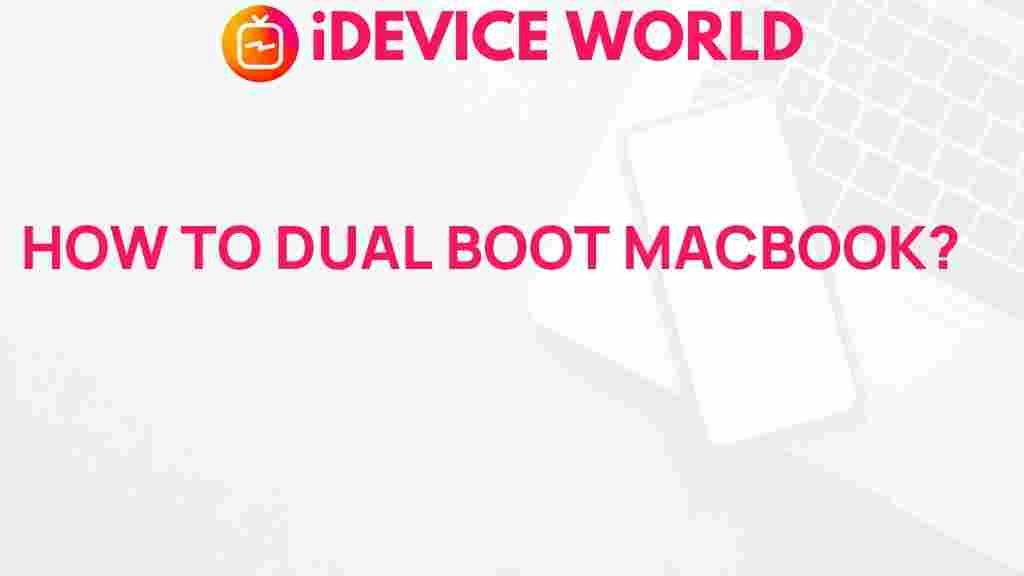Unleashing the Power of Dual Booting on Your MacBook
In today’s world, versatility and functionality are crucial for anyone using a laptop. One of the best ways to enhance the usability of your device is through dual booting, especially on your MacBook. Dual booting allows you to run two operating systems on a single machine, offering flexibility that can greatly improve your productivity. Whether you need macOS for its robust ecosystem or Windows for specific software applications, mastering dual booting can be a game changer.
What is Dual Booting?
Dual booting is the process of installing two operating systems on your computer, enabling you to choose which one to boot at startup. This can be particularly useful for MacBook users who wish to utilize the advantages of both macOS and Windows. With a dual boot setup, you can easily switch between operating systems based on your needs.
Why Dual Boot on Your MacBook?
- Access to Different Applications: Some applications are exclusive to Windows, and dual booting gives you access to these tools without needing a separate device.
- Performance: Running Windows on a MacBook natively through dual booting offers better performance compared to virtualization software.
- Flexibility: You can choose the operating system that best suits your current task, making your workflow more efficient.
Setting Up Dual Boot on Your MacBook
Setting up dual booting on your MacBook is a straightforward process. Follow these step-by-step instructions to get started:
Step 1: Prepare Your MacBook
Before you begin, ensure that your MacBook is up to date with the latest macOS version. This will help prevent compatibility issues during the installation of the second operating system.
Step 2: Backup Your Data
Always back up your data before modifying your system. Use Time Machine or any other backup tool to ensure that all your important files are safe.
Step 3: Create a Bootable USB Drive
You’ll need a bootable USB drive to install Windows. Here’s how to create one:
- Download the Windows ISO file from the official Microsoft website.
- Use the Boot Camp Assistant, found in the Utilities folder, to create your bootable USB drive.
Step 4: Use Boot Camp Assistant
Boot Camp Assistant will guide you through the installation of Windows on your MacBook:
- Open Boot Camp Assistant and follow the prompts.
- Select the Windows ISO file and the USB drive.
- Partition your drive: Decide how much space you want to allocate for Windows.
- Click Install to start the process.
Step 5: Install Windows
After partitioning, your Mac will restart and the Windows installation process will begin. Follow the on-screen instructions to complete the installation:
- Select the partition labeled “BOOTCAMP” during the Windows setup.
- Format the partition using NTFS if prompted.
- Continue with the Windows installation.
Step 6: Complete the Setup
Once Windows is installed, your MacBook will restart. You can choose which operating system to boot into by holding down the Option (Alt) key during startup.
Step 7: Install Boot Camp Drivers
After logging into Windows, it’s essential to install the Boot Camp drivers to ensure all hardware functions correctly:
- Insert the USB drive used to install Windows.
- Run the setup.exe from the Boot Camp folder on the USB drive.
- Follow the prompts to install the necessary drivers.
Troubleshooting Dual Boot Issues
While dual booting is generally a smooth process, you may encounter some issues. Here are some common problems and solutions:
Problem 1: Unable to Boot into Windows
If you can’t boot into Windows, try the following:
- Restart your Mac and hold the Option (Alt) key to select the Windows partition.
- If the issue persists, boot into macOS and use Boot Camp Assistant to repair the Windows partition.
Problem 2: Performance Issues
If Windows is running slowly, ensure that you have allocated enough disk space during the partitioning process. You might also consider optimizing Windows settings for better performance.
Problem 3: Driver Issues
Sometimes, hardware may not function correctly due to driver issues. Make sure to install the latest Boot Camp drivers and check for any updates:
- Go to the Boot Camp Control Panel in Windows.
- Check for updates and install them if available.
Conclusion
Dual booting on your MacBook unlocks a world of possibilities, allowing you to enjoy the best of both macOS and Windows. Whether you’re a developer needing specific tools, a gamer, or simply someone who enjoys the flexibility of two systems, mastering dual booting is essential. With careful preparation and a bit of troubleshooting, you can seamlessly switch between operating systems and enhance your overall productivity.
For more information about dual booting and other advanced MacBook tips, visit Apple’s official support page. If you’re interested in exploring more about optimizing your MacBook, check out our detailed guides here.
This article is in the category Guides & Tutorials and created by iDeciveWorld Team
